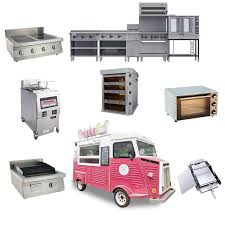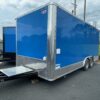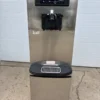
Essential Equipment Checklist for Your Food Trailer Business
food trailer equipment Starting a food trailer business requires careful planning and the right equipment to ensure success. This comprehensive checklist covers all the essential equipment you need to launch and operate a profitable mobile food business.
Cooking Equipment Essentials
The heart of your food trailer business lies in your cooking equipment. Selecting the right appliances ensures you can prepare quality food efficiently while maximizing your limited space.
Primary Cooking Appliances
Your primary cooking equipment should match your menu requirements. A commercial-grade flat top grill serves as the workhorse for most food trailers, offering versatility for burgers, sandwiches, and breakfast items. Consider a 36-inch or 48-inch model depending on your trailer size and expected volume.
Deep fryers are essential for trailers serving fried foods. A dual-basket fryer allows you to cook different items simultaneously while maintaining oil quality. Choose models with built-in filtration systems to extend oil life and reduce operating costs. food trailer equipment
Convection ovens provide consistent heating for baked goods, roasted items, and finishing dishes. Compact commercial convection ovens fit well in trailer spaces while delivering restaurant-quality results.
Specialized Cooking Equipment
Depending on your menu, specialized equipment can set you apart from competitors. Steamers work excellently for healthy menu options and keeping food warm during service. Char broilers create authentic grill marks and smoky flavors that customers love.
Consider a salamander or cheese melter for finishing touches on sandwiches and melting toppings. These compact units mount easily and add professional finishing capabilities to your operation.
Food Storage and Refrigeration
Proper food storage maintains quality and ensures food safety compliance. Your refrigeration system must handle the demands of mobile operation while maintaining consistent temperatures.
Refrigeration Units
Reach-in refrigerators provide easy access to frequently used ingredients. Choose units with solid doors for better temperature retention and energy efficiency. Two-door models offer good capacity while fitting most trailer layouts.
Undercounter refrigeration maximizes space utilization. These units fit beneath prep counters and cooking equipment, keeping ingredients within easy reach during busy service periods.
Freezer units are necessary for storing proteins, frozen ingredients, and ice cream products. Consider combination refrigerator-freezer units if space is limited, or dedicated freezer units for high-volume operations.
Dry Storage Solutions
Organized dry storage keeps ingredients fresh and accessible. Install shelving systems that secure items during transport while maximizing vertical space. Use clear, labeled containers for dry goods to maintain organization and prevent pest issues.
Consider pull-out drawers and sliding shelves that make accessing items easier in tight spaces. These systems prevent items from shifting during travel and improve workflow efficiency.
Food Preparation Equipment
Efficient food preparation equipment speeds service and maintains consistency. Your prep equipment should handle your menu requirements while fitting your available space.
Prep Tables and Surfaces
Stainless steel prep tables provide durable work surfaces that clean easily and resist corrosion. Choose tables with undershelf storage to maximize utility. Refrigerated prep tables keep ingredients at safe temperatures during preparation.
Cutting boards in various sizes and colors help prevent cross-contamination. Use color-coded systems to separate raw proteins from vegetables and ready-to-eat items.
Small Prep Equipment
Commercial food processors save time on chopping, slicing, and mixing tasks. Choose models with multiple attachments to handle various preparation needs. Immersion blenders work well for sauces and soups in limited space.
Digital scales ensure consistent portioning and recipe accuracy. Choose models that switch between metric and imperial measurements and can handle your typical batch sizes.
Sharp, professional knives are essential for efficient food preparation. Invest in quality knives and maintain them properly for safety and efficiency.
Serving and Service Equipment
Your service equipment creates the customer experience and affects operational efficiency. Choose equipment that speeds service while maintaining food quality.
Warming and Holding Equipment
Food warmers keep prepared items at safe serving temperatures. Steam tables work well for sauces and wet items, while heat lamps maintain temperature for fried foods and sandwiches.
Heated holding cabinets store larger quantities of prepared food at proper temperatures. These units are especially valuable for high-volume operations or catering events.
Service Accessories
Portion control tools ensure consistent serving sizes and control food costs. Use standardized scoops, ladles, and tongs for different menu items. This consistency builds customer trust and improves profitability.
Squeeze bottles and dispensers speed sauce application and reduce waste. Choose commercial-grade dispensers that withstand frequent use and cleaning.
Safety and Sanitation Equipment
Safety equipment protects your staff and customers while ensuring regulatory compliance. Proper sanitation equipment maintains food safety standards and protects your business reputation.
Fire Safety Systems
Fire suppression systems are typically required by local codes for commercial cooking operations. Install systems specifically designed for mobile food operations that can handle grease fires effectively.
Keep multiple fire extinguishers rated for grease fires in easily accessible locations. Train all staff on proper fire extinguisher use and evacuation procedures.
Sanitation Equipment
Three-compartment sinks are required in most jurisdictions for manual dishwashing. Choose compact models designed for food trailers that still meet regulatory requirements.
Hand washing stations with foot pedals or automatic sensors maintain hygiene standards. Install these stations away from food preparation areas but easily accessible to staff.
Sanitizing solution dispensers and test strips ensure proper chemical concentrations for effective sanitation. Regular testing demonstrates compliance with health department requirements.
Electrical and Power Equipment
Reliable power systems keep your equipment running smoothly. Your electrical setup must handle peak demand while providing backup options for equipment failures.
Generators and Power Management
Commercial generators provide independence from external power sources. Size your generator to handle all equipment simultaneously with some reserve capacity. Consider quiet-running models to reduce noise complaints.
Power distribution panels organize electrical connections and provide circuit protection. Professional installation ensures safety and code compliance while making troubleshooting easier.
Backup Power Solutions
Battery backup systems protect against brief power interruptions that could affect refrigeration or point-of-sale systems. These systems bridge power gaps during generator startup or utility switching.
Surge protectors safeguard expensive equipment from power fluctuations common with generator operation or varying utility power quality.
Point of Sale and Payment Systems
Modern payment systems accommodate customer preferences while tracking sales data. Your POS system should handle various payment methods while providing business analytics.
POS Hardware
Tablet-based POS systems offer flexibility and ease of use in mobile operations. Choose systems designed for food service with features like menu customization and inventory tracking.
Receipt printers and cash drawers complete your payment processing setup. Wireless models reduce cable clutter in tight spaces while maintaining reliability.
Payment Processing
Card readers that accept chip, swipe, and contactless payments accommodate all customer preferences. Mobile payment processors often offer competitive rates for small businesses.
Consider systems that work offline and sync when connectivity returns. This capability prevents lost sales during network outages or in areas with poor cellular coverage.
Ventilation and HVAC Systems
Proper ventilation removes cooking odors, heat, and grease while maintaining comfortable working conditions. Your ventilation system must meet local codes while operating efficiently.
Exhaust Systems
Commercial exhaust hoods capture cooking vapors and grease before they spread throughout your trailer. Choose hoods sized appropriately for your cooking equipment and install them according to manufacturer specifications.
Exhaust fans must move sufficient air volume to maintain proper ventilation. Variable speed controls adjust airflow based on cooking intensity while reducing energy consumption during slower periods.
Air Conditioning and Heating
Climate control systems maintain comfortable working conditions year-round. Choose efficient units sized for your trailer volume that can handle the heat load from cooking equipment.
Proper insulation reduces HVAC load and improves energy efficiency. This investment pays dividends in reduced operating costs and improved comfort.
Water Systems and Plumbing
Reliable water systems support food preparation, cleaning, and sanitation requirements. Your plumbing must handle operational demands while meeting health department standards.
Water Supply and Storage
Fresh water tanks store clean water for food preparation and cleaning. Size tanks based on your daily usage patterns and refilling opportunities. Consider multiple smaller tanks for better weight distribution.
Water pumps maintain consistent pressure throughout your system. Choose pumps rated for continuous duty with pressure switches that cycle automatically.
Waste Water Management
Gray water tanks collect waste water from sinks and equipment. Size these tanks appropriately for your fresh water capacity and local disposal requirements.
Grease traps prevent grease from entering waste water systems. Regular cleaning maintains proper function and prevents costly plumbing problems.
Storage and Organization Solutions
Efficient storage maximizes your limited space while keeping everything organized and accessible. Smart storage solutions improve workflow and reduce preparation time.
Interior Storage Systems
Overhead cabinets utilize vertical space for lightweight items and supplies. Secure latches prevent contents from spilling during transport while allowing easy access during operation.
Under-counter storage keeps heavy items low for stability while maximizing space utilization. Sliding drawers and pull-out shelves improve accessibility in deep storage areas.
External Storage Options
External storage compartments house items not needed during service like cleaning supplies and backup equipment. Weatherproof compartments protect stored items while freeing interior space for operations.
Propane storage requires proper ventilation and secure mounting. Follow local codes for propane storage and handling to ensure safety and compliance.
Maintenance and Cleaning Equipment
Regular maintenance keeps equipment running efficiently and extends service life. Having the right cleaning and maintenance tools prevents costly breakdowns and ensures food safety.
Cleaning Supplies and Equipment
Commercial cleaning chemicals designed for food service ensure effective sanitation. Stock degreasers, sanitizers, and general cleaners appropriate for your equipment and surfaces.
Cleaning tools like brushes, squeegees, and microfiber cloths maintain equipment and surfaces. Choose tools designed for commercial use that withstand frequent cleaning and sanitizing.
Basic Maintenance Tools
A basic tool kit enables minor repairs and adjustments. Include screwdrivers, wrenches, and specialty tools for your specific equipment. Quick repairs prevent lost sales and reduce service calls.
Replacement parts for common wear items like gaskets, filters, and heating elements prevent extended downtime. Stock parts for critical equipment that could shut down operations if they fail.
Starting a food trailer business requires significant investment in quality equipment, but choosing the right tools sets the foundation for success. This comprehensive checklist ensures you have everything needed to operate efficiently while maintaining food safety and customer satisfaction. Remember that equipment needs vary based on your specific menu and local requirements, so consult with FDA food safety guidelines and local health departments during your planning process.
Quality equipment may require higher upfront investment, but it pays dividends through reliability, efficiency, and longevity. Work with reputable suppliers who understand mobile food operations and can provide ongoing support. Regular maintenance and proper operation extend equipment life and ensure consistent performance throughout your business journey.


